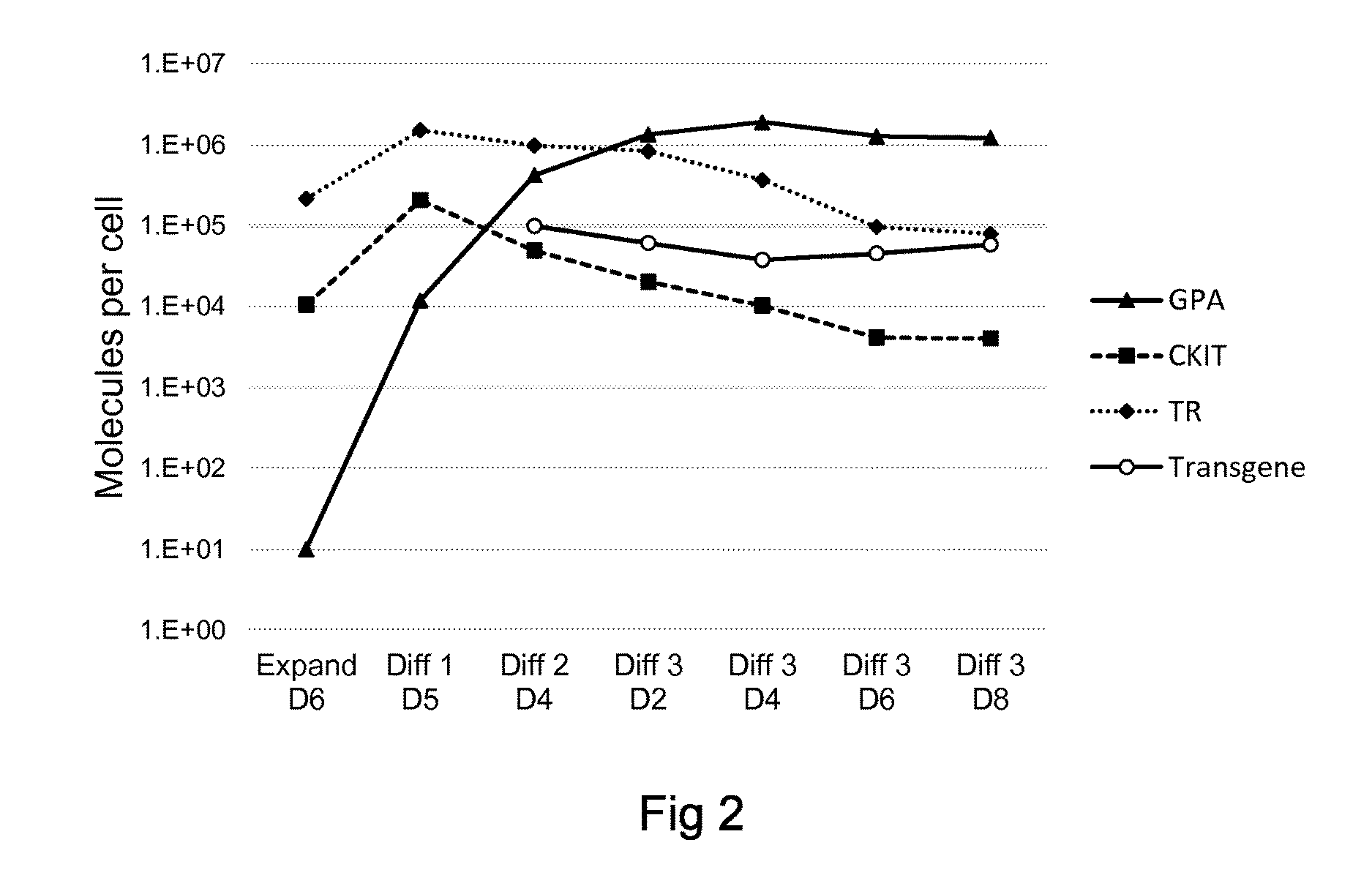Methods and compositions for immunomodulation
a technology of immunomodulation and composition, applied in the field of pharmaceutical compositions for the treatment of diseases and disorders, can solve the problems of lack of long-term efficacy, significant morbidities, and destruction of polypeptides and proteins used in the treatment of a range of human diseases, and achieve the effect of effectively reducing the concentration of antigen-specific immune cells and reducing the concentration of antigen-specifi
- Summary
- Abstract
- Description
- Claims
- Application Information
AI Technical Summary
Benefits of technology
Problems solved by technology
Method used
Image
Examples
example 1
Culture of Erythroid Cells with Heterologous Gene Expression
[0586]CD34 cells are isolated from peripheral blood by supermagnetic microbead selection by the use of Mini-MACS columns (Miltenyi Biotec; 94%+ / −3% purity). The cells are cultured in erythroid differentiation medium (EDM) on the basis of IMDM supplemented with stabilized glutamine, 330 ug / mL holo-human transferrin, 10 ug / mL recombinant human insulin, 2 IU / mL heparin, and 5% solvent / detergent virus-inactivated plasma. The expansion procedure comprises 3 steps. In the first step (day 0 to day 7), 10̂4 / mL CD34 cells are cultured in EDM in the presence of 1 uM hydrocortisone, 100 ng / mL SCF, 5 ng / mL IL-3, and 3 IU / mL Epo. On day 4, 1 volume of cell culture is diluted in 4 volumes of fresh medium containing SCF, IL-3, Epo, and hydrocortisone. In the second step (day 7 to day 11), the cells are resuspended at 10̂5 / mL in EDM supplemented with SCF and Epo. In the third step (day 11 to day 18), the cells are cultured in EDM supplemen...
example 2
Loading of Protein into Erythroid Cell by Hypotonic / Hypertonic Cycling
[0588]Antigen, in this case OVA, is added to a RBC suspension at a final concentration of 0.5 or 5 mg / ml with a hematocrit (Hct) of 70%. After a hypotonic dialysis process (50 mOsmol / kg), RBC are resealed by adding a hypertonic solution (1900 mOsmol / kg) at 37 C for 30 min. OVA-loaded RBC are washed four times with a 0.9% NaCl+0.2% glucose solution, centrifuged at 1000×g for 10 min at 4 C and adjusted to a Hct of 50% with plasma or buffer.
example 3
Cell Surface Labeling with Heterobifunctional Crosslinker
[0589]Antigen with exposed, reduced thiol group (antigen-SH) is prepared by incubation with 5 mM TCEP. The reducing agent is removed by size exclusion chromatography prior to conjugation. Cells are incubated with maleimide-PEG-NHS crosslinker, e.g. SM(PEG)x (Thermo Scientific) for 30 minutes. The NHS group reacts with free amine groups on cell surface antigens. Reacted cells are washed in PBS to remove excess crosslinker. Antigen-SH solution is introduced to the cells-plus-crosslinker ssolution, and the maleimide-SH reaction is allowed to proceed for 30 minutes. Cells are pelleted and washed to remove unbound antigen.
PUM
| Property | Measurement | Unit |
|---|---|---|
| volume | aaaaa | aaaaa |
| volume | aaaaa | aaaaa |
| volume | aaaaa | aaaaa |
Abstract
Description
Claims
Application Information
 Login to View More
Login to View More - R&D
- Intellectual Property
- Life Sciences
- Materials
- Tech Scout
- Unparalleled Data Quality
- Higher Quality Content
- 60% Fewer Hallucinations
Browse by: Latest US Patents, China's latest patents, Technical Efficacy Thesaurus, Application Domain, Technology Topic, Popular Technical Reports.
© 2025 PatSnap. All rights reserved.Legal|Privacy policy|Modern Slavery Act Transparency Statement|Sitemap|About US| Contact US: help@patsnap.com



